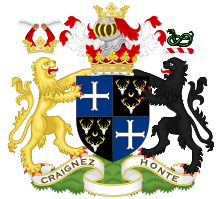William Cavendish-Bentinck, 3rd Duke of Portland

William Henry Cavendish-Bentinck, 3rd Duke of Portland (born April 14, 1738 in Nottinghamshire , † October 30, 1809 in Bulstrode , Buckinghamshire ), was a British politician of the Whigs and the Tories and Prime Minister in 1783 and 1807-1809 .
Life
He was born William Henry Bentinck, the eldest son of William Bentinck, 2nd Duke of Portland and Margaret Harley . As his father's apparent marriage , he carried the courtesy title of Marquess of Titchfield until 1762 . He later added a Royal License to Cavendish-Bentinck to his family name on October 5, 1801, and added that of that family to his coat of arms .
He was at the Westminster School educated and graduated in 1757 his studies at Christ Church College of Oxford University as a Master of Arts from. 1761 he was appointed as a deputy for the Borough Weobley in Herefordshire in the House of Commons voted. A year later he moved into the House of Lords after inheriting the Duke of Portland title when his father died . He was the aristocratic Whig party of Charles Watson-Wentworth, 2nd Marquess of Rockingham , close. He served in his first government (1765-1766) as Lord Chamberlain of the Household and then, in Rockingham's second term (April-August 1782), as Lord Lieutenant of Ireland . After Rockingham's death, he was no longer a member of the government of William Petty, 2nd Earl of Shelburne , as he was a supporter of Charles James Fox .
In April 1783, Bentinck came into the limelight as the nominal head of a coalition government. Their real leaders, however, were James Fox and Lord North . He was a member of that government as Lord of the Treasury until it fell apart in December of the same year.
Like many other conservative Whigs (including Edmund Burke ), the Duke felt a profound discomfort with the French Revolution . He fell out with Fox over the problem and in 1794 joined Pitt's government as Secretary of the Interior. He was a member of the Cabinet until Pitt's death in 1806 - from 1801 to 1805 as Lord President of the Council , then as Minister without Portfolio.
In 1794 he was accepted into the Order of the Garter.
When Pitt's supporters came back to power after the overthrow of the " government of all talents " in March 1807, Bentinck was again an acceptable figurehead for a squabble group of ministers such as George Canning , Lord Castlereagh , Lord Hawkesbury and Spencer Perceval .
Cavendish-Bentinck's second government experienced the complete isolation of the United Kingdom from the continent ( continental blockade by Napoleon ), but also the beginning of the recovery, as the Spanish War of Independence began. In the fall of 1809, the Duke resigned because of his poor health and because of the scandalous duel between Canning and Castlereagh. Shortly afterwards he died.
Trivia
The Portland vase is named after his family, to whom it belonged at times.
Marriage and offspring
Cavendish-Bentinck married Dorothy Cavendish (1750–1794), daughter of William Cavendish, 4th Duke of Devonshire , in 1766 . The couple had the following children:
- William Cavendish-Scott-Bentinck, 4th Duke of Portland (1768-1854)
- Lady Charlotte Cavendish-Bentinck (1773–1862) ⚭ 1793 Charles Greville
- Lord William Henry Cavendish-Bentinck (1774–1839)
- Lord William Charles Cavendish-Bentinck (1780–1826) ⚭ (1) 1808 Georgiana Seymour, ⚭ (2) 1816 Lady Anne Wellesley, daughter of Richard Colley-Wellesley, 1st Marquess Wellesley
- Lord Frederick Cavendish-Bentinck (1781–1828) ⚭ 1820 Lady Mary Lowther, daughter of William Lowther, 1st Earl of Lonsdale
literature
- HCG Matthew: Bentinck, William Henry Cavendish . In: Leslie Stephen (Ed.): Dictionary of National Biography . Volume 4: Beal - Beaver. , MacMillan & Co, Smith, Elder & Co., New York City / London 1885, pp. 302 - 304 (English).
Web links
- William Henry Cavendish-Bentinck, 3rd Duke of Portland on thepeerage.com
| predecessor | Office | successor |
|---|---|---|
| William Bentinck |
Duke of Portland 1762-1809 |
William Cavendish-Scott-Bentinck |
| Granville Leveson-Gower |
Lord Chamberlain 1765-1766 |
Francis Seymour-Conway |
| Frederick Howard |
Lord Lieutenant of Ireland 1782 |
George Nugent-Temple-Grenville |
| Henry Dundas |
Home Secretary 1794-1801 |
Thomas Pelham |
| John Pitt |
Lord President of the Council 1801-1805 |
Henry Addington |
| personal data | |
|---|---|
| SURNAME | Cavendish-Bentinck, William, 3rd Duke of Portland |
| ALTERNATIVE NAMES | Cavendish-Bentinck, William Henry, 3rd Duke of Portland; Bentinck, William, Marquess of Titchfield |
| BRIEF DESCRIPTION | British politician and Prime Minister |
| DATE OF BIRTH | April 14, 1738 |
| PLACE OF BIRTH | Nottinghamshire |
| DATE OF DEATH | October 30, 1809 |
| Place of death | Bulstrode , Buckinghamshire |


